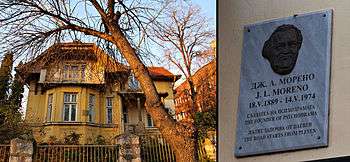Jacob L. Moreno
| Jacob L. Moreno | |
|---|---|
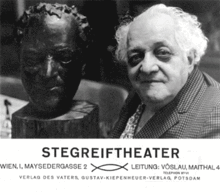 | |
| Born |
Iacob Levy May 18, 1889 Bucharest, Romania |
| Died |
May 14, 1974 (aged 84) Beacon, New York, U.S. |
| Residence | New York, U.S. |
| Alma mater | University of Vienna |
| Known for | Sociometry, psychodrama |
| Spouse(s) | Zerka T. Moreno |
| Scientific career | |
| Fields | Theory, education, psychiatry, psychology, psychotherapy, social psychology |
| Influenced | Kurt Lewin, Martin Buber, Fritz Perls |
Jacob Levy Moreno (born Iacob Levy; May 18, 1889 – May 14, 1974) was a Romanian-American psychiatrist, psychosociologist, and educator, the founder of psychodrama, and the foremost pioneer of group psychotherapy. During his lifetime, he was recognized as one of the leading social scientists.
Early life and education
Jacob Levy Moreno was born in Bucharest in the Kingdom of Romania. His father was Moreno Nissim Levy, a Sephardi Jewish merchant born in 1856 in Plevna in the Ottoman Empire (today Pleven, Bulgaria). Jacob's grandfather Buchis had moved to Plevna from Constantinople, where his ancestors had settled after they left Spain in 1492. It is thought that the Morenos left Plevna for Bucharest during the Russo-Turkish War of 1877–1878, following the Plevna rabbi, Haim Bejarano in search of a more hospitable environment. Jacob Moreno's mother, Paulina Iancu or Wolf, was also a Sephardi Jew, born in 1873, and originated from Călăraşi, Romania.[1]
In 1895, a time of great intellectual creativity and political turmoil, the family moved to Vienna. He studied medicine, mathematics, and philosophy at the University of Vienna, becoming a Doctor of Medicine in 1917. He had rejected Freudian theory while still a medical student, and became interested in the potential of group settings for therapeutic practice.[2]
In his autobiography, Moreno recalls this encounter with Sigmund Freud in 1912. "I attended one of Freud’s lectures. He had just finished an analysis of a telepathic dream. As the students filed out, he singled me out from the crowd and asked me what I was doing. I responded, 'Well, Dr. Freud, I start where you leave off. You meet people in the artificial setting of your office. I meet them on the street and in their homes, in their natural surroundings. You analyze their dreams. I give them the courage to dream again. You analyze and tear them apart. I let them act out their conflicting roles and help them to put the parts back together again.'"[3]
Marriages and children
In Brooklyn, New York, Moreno married Beatrice Beecher in 1926. The marriage ended in divorce, and in 1938 he married Florence Bridge, with whom he had one child, Regina (born 1939). They too were divorced, and he married Zerka Toeman in 1949, with whom he had one child Jonathan D. Moreno (born 1952).[4]
Career
While living in Vienna in the early 1900s Moreno started an improvisational theater company, Stegreiftheater, the Theater of Spontaneity [5]:72 where he formulated a form of psychotherapy he called psychodrama, which employed improvised dramatizations, role-plays and other therapeutic, spontaneous dramatic expressions that utilized and unleashed the spontaneity and creativity of the group and its individual members.[5]:15,16 Moreno saw "psychodrama as the next logical step beyond psychoanalysis." It was "an opportunity to get into action instead of just talking, to take the role of the important people in our lives to understand them better, to confront them imaginatively in the safety of the therapeutic theater, and most of all to become more creative and spotantaneous human beings."[5]:50
In his book Who Shall Survive? (Preludes, p.xxviii) Moreno wrote of the genesis of his Group Psychotherapy in 1913-14 in Vienna, formulating his ideas while working with groups of prostitutes.
Moving to the U.S. in 1925, he began working in New York City. In this country, Moreno worked on his theory of interpersonal relations, and the development of his work in psychodrama, sociometry, group psychotherapy, sociodrama, and sociatry. In his autobiography he wrote "only in New York, the melting pot of the nations, the vast metropolis, with all its freedom from all preconceived notions, could I be free to pursue sociometric group research in the grand style I had envisioned".[6]
He later held positions at Columbia University[7] and the New School for Social Research.[8]
In 1932, Moreno first introduced group psychotherapy to the American Psychiatric Association, and co-authored the monograph Group Method and Group Pschotherapy with Helen Hall Jennings.[9] For the next 40 years he developed and introduced his Theory of Interpersonal Relations and tools for social sciences he called 'sociodrama', 'psychodrama', 'sociometry', and 'sociatry'. In his monograph entitled, "The Future of Man's World", he describes how he developed these sciences to counteract "the economic materialism of Marx, the psychological materialism of Freud, and the technological materialism" of our modern industrial age.[10]
His autobiography describes his position as "threefold:
- Spontaneity and creativity are the propelling forces in human progress, beyond and independent of libido and socioeconomic motives [that] are frequently interwoven with spontaneity-creativity, but [this proposition] does deny that spontaneity and creativity are merely a function and derivative of libido or socioeconomic motives.
- Love and mutual sharing are powerful, indispensable working principles in group life. Therefore, it is imperative that we have faith in our fellow man’s intentions, a faith which transcends mere obedience arising from physical or legalistic coercion.
- That a super dynamic community based on these principles can be brought to realization through new techniques..."[3]
Moreno died in New York City in 1974, aged 84.[2] He chose to die by abstaining from all food and water after a long illness. His epitaph, at his request, reads "the man who brought laughter to psychiatry."[11]
Summary of contribution
There is evidence that the methods of J. L. Moreno have held up respectably over time.[12] Subsequent research from the University of Vienna shows the enormous influence that Moreno's theory of the Encounter (Invitations to an Encounter, 1914) had on the development of Martin Buber's I-Thou philosophy, and Buber's influence on philosophy, theology, and psychology.[13] His wife, Zerka Moreno, wrote: "While it is true that Buber broadened the idea of the Encounter, he did not create the instruments for it to occur." Moreno "produced the various instruments we now use for facilitating the human encounter, sociometry, group psychotherapy, psychodrama, and sociodrama".[14] Zerka was herself an expert in psychodrama and sociometry, and continued her late husband's work.[15]
With training centers and institutes on nearly every continent, there are many thousands of students who are expanding and developing training and teaching the Morenean Arts and Sciences across the disciplines, to more fully realize Moreno's vision to make these social sciences available for "the whole of [hu]mankind."[16]
Moreno is also widely credited as one of the founders of the discipline of social network analysis, the branch of sociology that deals with the quantitative evaluation of an individual's role in a group or community by analysis of the network of connections between them and others.[5]:21,22
His 1934 book Who Shall Survive? contains some of the earliest graphical depictions of social networks (sociograms). In this book, he introduced a famous explanation, why a pandemic of runaways emerged at the New York Training School for Girls in Hudson.
- Sociograms
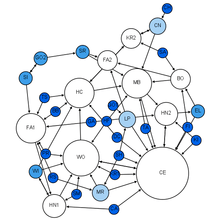 1st Grade
1st Grade 2nd Grade
2nd Grade 3rd Grade
3rd Grade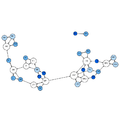 4th Grade
4th Grade 5th Grade
5th Grade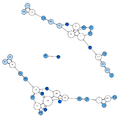 6th Grade
6th Grade 7th Grade
7th Grade 8th Grade
8th Grade
Selected works by J. L. Moreno
- Moreno, J. L. (1932). First Book on Group Therapy. Beacon House.
- Moreno, J. L. (1934). Who Shall Survive? A new Approach to the Problem of Human Interrelations. Beacon House. ISBN 978-9992695722
- Moreno, J. L. (1941). The Words of the Father. Beacon House. ISBN 978-1446601853
- Moreno, J. L. (1946). Psychodrama Volume 1. Beacon House.
- Moreno, J. L. (1947). The Theatre of Spontaneity Beacon House. ISBN 978-1445777139
- Moreno, J. L. (1951). Sociometry, Experimental Method and the Science of Society: An Approach to a New Political Orientation. Beacon House. ISBN 978-1291121759
- Moreno, J. L. (1953). Who Shall Survive? Foundations of Sociometry, Group Psychotherapy and Sociodrama. Beacon House.
- Moreno, J. L. (1956). Sociometry and the Science of Man. Beacon House.
- Moreno, J. L. (1959). Psychodrama Volume 2: Foundations of Psychodrama. Beacon House.
- Moreno, J. L. (1960). The Sociometry Reader. Beacon House.
- Moreno, J. L., Moreno, Z. T., Moreno, J. D. (1964). The First Psychodramatic Family. Beacon House.
- Moreno, J. L. (1966). The International Handbook of Group Psychotherapy. Philosophical Library.
- Moreno, J. L. (1969). Psychodrama Volume 3: Action Therapy and Principles of Practice. Beacon House.
- Moreno, J. L. (1989). Preludes of my Autobiography. Beacon House.
References
- ↑ Marineau, René F. (1989). "Ancestors and family: the birth of a myth". Jacob Levy Moreno, 1889-1974: father of psychodrama, sociometry, and group psychotherapy. Routledge. pp. 4–6. ISBN 978-0-415-04383-0.
- 1 2 Biographical detail: article by Lucy Ozarin, Psychiatric News (Volume 38, Number 10), May 16, 2003. Retrieved on December 29, 2007.
- 1 2 The Autobiography of J. L. Moreno, M.D. (Abridged), J. L. Moreno, Moreno Archives, Harvard University, 1985.
- ↑ Jacob Moreno from American National Biography
- 1 2 3 4 Moreno, Jonathan D. (2014). Impromptu Man (1st ed.). NYU School of Medicine, NY: Bellevue Literary Press. ISBN 978-1-934137-84-0.
- ↑ Journal of Group Psychotherapy, Psychodrama & Sociometry (Vol. 42, No. 1), J. L. Moreno, spring 1989.
- ↑ Taught at Columbia University Archived 2009-01-06 at the Wayback Machine., evidenced in recollection: article by Mary Nicholas & Gene Eliasoph, The Group Circle (August/September 2002), American Group Psychotherapy Association. Retrieved on December 30, 2007.
- ↑ New School for Social Research Archived 2007-07-08 at the Wayback Machine.: short biography at SibiuOnline website. Retrieved on December 30, 2007.
- ↑ https://books.google.com.au/books?id=-qkaAAAAIAAJ&q=inauthor:%22Jacob+Levy+Moreno%22&dq=inauthor:%22Jacob+Levy+Moreno%22&hl=en&sa=X&ved=0ahUKEwievfiG163UAhULfrwKHVmrD9g4ChDoAQgwMAU
- ↑ The Future of Man's World, J. L. Moreno, New York Beacon House, Psychodrama Monographs, 1947.
- ↑ Johnson, David Read; Emunah, Renée, eds. (2009). Current Approaches in Drama Therapy (2nd ed.). Springfield, IL: Charles C. Thomas. p. 394. ISBN 978-0-398-07848-5.
- ↑ Psychotherapy Networker, Clinician's Digest, January/February 2007.
- ↑ J.L. MORENO’S INFLUENCE ON MARTIN BUBER’S DIALOGICAL PHILOSOPHY. Robert Waldl. http://www.blatner.com/adam/pdntbk/BuberMoreno.html
- ↑ Psychodrama Network News, Zerka Moreno, winter 2007.
- ↑ "Zerka Moreno". Psychotherapy.net. September 2004.
- ↑ Morenean Arts & Sciences: Moreno Institute East website. Retrieved on December 29, 2007.
Further reading
- Marineau, René. (1992) Jacob Levy Moreno 1889-1974: father of psychodrama, sociometry and group psychotherapy. Create Space Independent Publishing Platform.
- Moreno, Jonathan D. (2014) Impromptu Man: J.L. Moreno and the Origins of Psychodrama, Encounter Culture, and the Social Network. Bellevue Literary Press.
- Nolte, John. (2014) The Philosophy, Theory and Methods of J. L. Moreno: The Man Who Tried to Become God (Explorations in Mental Health). Routledge.
External links
- Psychodrama and Life with J.L. Moreno: An Interview with Zerka Moreno (Psychotherapy.net)
- Jonathan Moreno’s "Impromptu Man: J.L. Moreno and the Origins of Psychodrama, Encounter Culture, and the Social Network" (Radio Times, WHYY Philadelphia)
